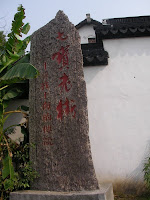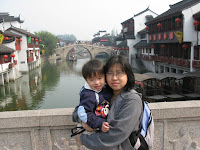Qibao 七宝古镇 is a small town about two square kilometers in size which is crossed by two canals. Around the canals, a large number of traditional houses, shops and restaurants are found. The official website for this town is at http://www.goqibao.com/
Our driver dropped us at one end of the town so that we could walk towards the other end where he parked the car. This way it would save us effort of not having to walk back to the place where we started.
Captured the map of this town
There was a large billboard advertising this ancient town near where our driver dropped us off. We could even find a wooden water wheel that is turned by the water jet shot from a stone fish's mouth.Stone tablet with the town's name carved on it. It was amazing that there were so many people and tourist even on a week day, Monday today.


The town was built in Northern Song Dynasty (960-1126) and grew into a prosperous business center during Ming (1368-1644) and Qing Dynasties (1644-1911).


Qibao is the Chinese for 'seven treasures' and there are two popular theories about its derivation. The more reliable one says that the name originates from the Qibao Temple, famed for its good reputation. It was this that contributed to the growth of business and culture of the previously unknown town.

Initially we tried to find the memorial hall of the artist Zhang Chongren 张充仁纪念馆. However we found it as shown in photo below, it was very small building that needs RMB5 for entry.
We wandered around the old town, walking on its narrow street. Certain section of the streets were packed with visitors.
Came across a restaurant with quite some history. Amazed to see so many people eating at this place. This place reminds me of the tourist infested Yu Garden.


After walking for quite a distance, we came to one of the entrance to this ancient town. Here, there was a small pagoda building and also a rock formation with a pavilion for viewing on top.



















































